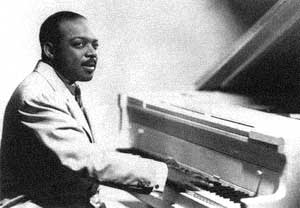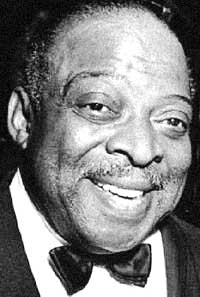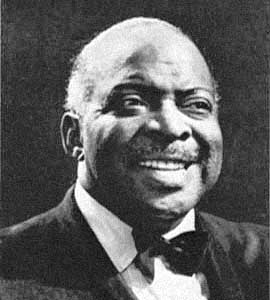
Count Basie
- Подробности
 William "Count" Basie (August 21, 1904 – April 26, 1984) was an American jazz pianist, organist, bandleader, and composer. Commonly regarded as one of the most important jazz bandleaders of his time, Count BasieBasie led his popular Count Basie Orchestra for almost fifty years. Many notable musicians came to prominence under his direction, including tenor saxophonists Lester Young and Herschel Evans, trumpeters Buck Clayton and Harry "Sweets" Edison and singers Jimmy Rushing and Joe Williams. Basie's theme songs were "One O'Clock Jump" and "April In Paris." "Every Day I Have The Blues" (1955), sung by the deep-voiced Williams, was also a hit. Basie was a member of the Omega Psi Phi fraternity.
William "Count" Basie (August 21, 1904 – April 26, 1984) was an American jazz pianist, organist, bandleader, and composer. Commonly regarded as one of the most important jazz bandleaders of his time, Count BasieBasie led his popular Count Basie Orchestra for almost fifty years. Many notable musicians came to prominence under his direction, including tenor saxophonists Lester Young and Herschel Evans, trumpeters Buck Clayton and Harry "Sweets" Edison and singers Jimmy Rushing and Joe Williams. Basie's theme songs were "One O'Clock Jump" and "April In Paris." "Every Day I Have The Blues" (1955), sung by the deep-voiced Williams, was also a hit. Basie was a member of the Omega Psi Phi fraternity.
Early life
William James Basie was born on August 21,1904 in Red Bank, New Jersey to Harvey Lee Basie and Lillian Ann Childs, who lived on Mechanic Street. His father worked as coachman for a wealthy family. After automobiles replaced horses, his father became a groundskeeper and handyman for several families in the area. His mother took in laundry, and was Bill Basie's first piano teacher when he was a child. He started out to be a drummer, but the obvious talents of another young Red Bank drummer, Sonny Greer (who was Duke Ellington's drummer from 1919 to 1951), discouraged young Basie and he switched to piano. While he was in his late teens, he gravitated to Harlem, where he met Fats Waller who taught him how to play organ.
Basie toured the Keith circuit before the age of 20 and later the Columbia Burlesque and the Theater Owners Bookers Association (T.O.B.A.) vaudeville circuits starting in 1924 as a soloist, accompanist to blues singers Katie Krippen and Gonzelle White and music director for various acts. His touring took him to Kansas City, Missouri, where he met many jazz musicians in the area. In 1928 he joined Walter Page's Blue Devils, and the following year became the pianist with the Bennie Moten band based in Kansas City. It was at this time that he began to be known as "Count" Basie (see Jazz royalty).
He started his own band in 1934, but eventually returned to Moten's band. After Moten died in 1935, the band unsuccessfully attempted to stay together. Basie formed a new band, which included many Moten alumni.
New York City and later years
At the end of 1936, Bill Basie moved his band from Kansas City; they honed their repertoire at a long engagement at the Grand Terrace Ballroom in Chicago. In that city in October 1936, members of the band participated in a recording session which producer John Hammond later described as "the only perfect, completely perfect recording session I've ever had anything to do with" . Those four sides were released under the name Jones-Smith Incorporated because Basie had already signed with Decca but had not started recording for them (his first Decca session was January, 1937). By the end of 1936 the Count Basie Orchestra began playing in New York City, where they remained until 1950.
Basie’s music was characterized by his trademark "jumping" beat and the contrapuntal accents of his own piano. Basie also showcased some of the most notable blues singers of the era: Billie Holiday, Jimmy Rushing, Big Joe Turner, Helen Humes, and Joe Williams. More importantly, Count Basie was a highly successful bandleader who was able to hold onto some of the most notable jazz musicians of the 1930s and early 1940s: Buck Clayton, Reunald Jones, Herschel Evans, Lester Young, and the band's rhythm section, including Walter Page, Freddie Green, and Jo Jones. He was also able to hire arrangers who knew how to accentuate the band's abilities, such as Eddie Durham and Jimmy Mundy.
The big band era appeared to be at an end, but Basie reformed his as a 16-piece orchestra in 1952 and led it until his death. Basie remained faithful to the Kansas City Jazz style and helped keep big bands alive with his distinctive style of piano playing.
By the mid-1950s, Basie's band had become one of the pre-eminent backing big bands for some of the finest jazz vocalists of the time. Joe Williams was featured on the 1957 album One O'Clock Jump, and 1956's Count Basie Swings, Joe Williams Sings. Tony Bennett, Sammy Davis, Jr. and Frank Sinatra also recorded with Basie. In 1942 Basie moved to Queens, New York with Catherine Morgan after being married for a few years. In 1957 Basie released the live album At Newport. He appeared as himself (along with his band) in the Jerry Lewis film Cinderfella (1960) and in the Mel Brooks movie Blazing Saddles (1974).
Ella Fitzgerald is sometimes referred to as the quintessential swing singer, and her meetings with the Basie band are highly regarded by critics[citation needed]. Fitzgerald's 1963 album Ella and Basie! is remembered as one of Fitzgerald's greatest recordings. With the 'New Testament' Basie band in full swing, and arrangements written by a youthful Quincy Jones, this album proved a swinging respite from the 'Songbook' recordings and constant touring that Fitzgerald was engaged in during this period. She toured with the Basie Orchestra in the mid-1970s, and Fitzgerald and a much tamer Basie band also met on the 1979 albums Digital III at Montreux, A Classy Pair, and A Perfect Match, the last two also recorded live at Montreux.
Frank Sinatra had a fruitful relationship with Basie -- 1963's Sinatra-Basie and 1964's It Might as Well Be Swing (the latter arranged by Quincy Jones) are two high points towards the peak of Sinatra's artistry. Jones provided the punchy arrangements for the Basie band on Sinatra's biggest selling album, the live Sinatra at the Sands. Basie also recorded with Tony Bennett in the early 1960s-two of their best were the live recording at Las Vegas and Strike Up the Band, a studio album.
Basie was especially known for his use of some of the best known arrangers in the business: Benny Carter (Kansas City Suite), Neal Hefti (Atomic Basie), and Sammy Nestico (Basie-Straight Ahead). Serious students of big band[Neutrality disputed — See talk page] jazz still consider his Chairman of the Board album from the mid-1950s arguably his best pure big band album (sans vocals).
Bill Basie died of pancreatic cancer in Hollywood, Florida on April 26, 1984 at the age of seventy-nine.
Legacy
"One O'Clock Jump" and "Jumpin' at the Woodside" were among Count Basie's more popular numbers[citation needed]. Basie was also known for his band's version's of "April in Paris" and "Lil' Darlin."
Jerry Lewis used "Blues in Hoss' Flat," from Basie's Chairman of the Board album, as the basis for his own "Chairman of the Board" routine in the movie The Errand Boy, in which Lewis pantomimed the movements of a corporate executive holding a board meeting. (In the early 1980s, Lewis revived the routine during the live broadcast of one of his Muscular Dystrophy Association telethons.) "Blues in Hoss' Flat," composed by Basie band member Frank Foster, was also the longtime theme song of San Francisco and New York radio DJ Al "Jazzbeaux" Collins.
Basie and his band made a cameo appearance in Mel Brooks' 1974 comedy film Blazing Saddles, playing his arrangement of "April in Paris".
He received one of the Kennedy Center Honors in 1981.
Basie was awarded a Grammy Lifetime Achievement Award in 2002.
Basie is one of the producers of the "world's greatest music" that Brenda Fricker's "Pigeon Lady" character claims to have heard in Carnegie Hall in 1992's Home Alone 2: Lost in New York.
Count Basie, considered one of the greatest jazz musicians in musical history, was inducted into the Long Island Music Hall of Fame October 21, 2007.
The Count Basie Theatre in Red Bank, New Jersey was named in his honor.
Main menu
Anthology
Sheet Music Archive
 lesson 1lesson 2lesson 3
lesson 1lesson 2lesson 3

